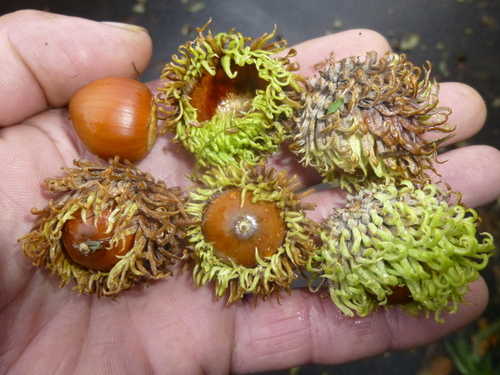Sawtooth Oak
Quercus acutissimaSummary 9
Quercus acutissima, the sawtooth oak, is an oak originally native to eastern Asia, in China, Korea and Japan. It is now also present in North America. It is closely related to the turkey oak, classified with it in Quercus sect. Cerris, a section of the genus characterised by shoot buds surrounded by soft bristles, bristle-tipped leaf lobes, and acorns that mature in about 18 months.
Description 10
Sawtooth oak, a tree native to eastern Asia, is popular for use in street tree plantings due to its interesting foliage and fruits (acorns). It spreads by seed that is produced in large numbers and has been found in recent years to be escaping from plantings to become invasive in wild areas, displacing native plants. Because of this, land managers recommend against the use of sawtooth oak and suggest instead that landscapers use native oaks, of which there are many species to choose. One observer noted that it readily seeds into woodland edges, meadow habitats and open areas. Sawtooth oak successfully establishes in edge habitats that are not managed by mowing or other woody plant control. With regular, annual and semiannual mowing it does not seem to persist. If not mowed, however, it is fast growing, tolerant of a wide range of moisture and temperature conditions and can become a troublesome invasive. Do not plant sawtooth oaks. If small, pull seedlings or treat leaves with glyphosate. To control large trees: cut tree and grind stump; girdle, hack and squirt glyphosate; or cut and paint stump with glyphosate. Alternative plants include shagbark hickory (Carya ovata), American beech (Fagus grandifolia), red oak (Quercus rubra) and many other lovely native trees.
Ecology 11
The acorns are very bitter, but are eaten by jays and pigeons; squirrels usually only eat them when other food sources have run out. The sap of the tree can leak out of the trunk. Beetles, stag beetles, butterflies, and Vespa mandarinia japonica gather to reach this sap.
Sources and Credits
- (c) Janet Tarbox, some rights reserved (CC BY-NC), https://www.flickr.com/photos/tarboxje/6211899328/
- (c) harum.koh, some rights reserved (CC BY-SA), uploaded by harum.koh, https://www.flickr.com/photos/harumkoh/15911547655/
- (c) harum.koh, some rights reserved (CC BY-SA), uploaded by harum.koh
- (c) thehaplesshiker, some rights reserved (CC BY-NC), uploaded by thehaplesshiker
- (c) Ken Bosso, some rights reserved (CC BY-NC), uploaded by Ken Bosso
- (c) harum.koh, some rights reserved (CC BY-SA), uploaded by harum.koh, https://www.flickr.com/photos/harumkoh/17107869661/
- (c) Evan M. Raskin, some rights reserved (CC BY), uploaded by Evan M. Raskin
- (c) Maurice, some rights reserved (CC BY-NC), uploaded by Maurice
- Adapted by Kate Wagner from a work by (c) Wikipedia, some rights reserved (CC BY-SA), http://en.wikipedia.org/wiki/Quercus_acutissima
- (c) Unknown, some rights reserved (CC BY-NC-SA), http://eol.org/data_objects/22734071
- (c) Wikipedia, some rights reserved (CC BY-SA), http://en.wikipedia.org/wiki/Quercus_acutissima
More Info
- iNat taxon page
- African Plants - a photo guide
- Biodiversity Heritage Library
- BOLD Systems BIN search
- eFloras.org
- Flora of North America (beta)
- Global Biodiversity Information Facility (GBIF)
- Go Botany
- HOSTS - a Database of the World's Lepidopteran Hostplants
- IPNI (with links to POWO, WFO, and BHL)
- Maryland Biodiversity Project
- NatureServe Explorer 2.0
- NBN Atlas
- New Zealand Plant Conservation Network
- SEINet Symbiota portals
- Tropicos
- USDA PLANTS database
- World Flora Online
- 日本のレッドデータ検索システム
- 植物和名−学名インデックス YList














